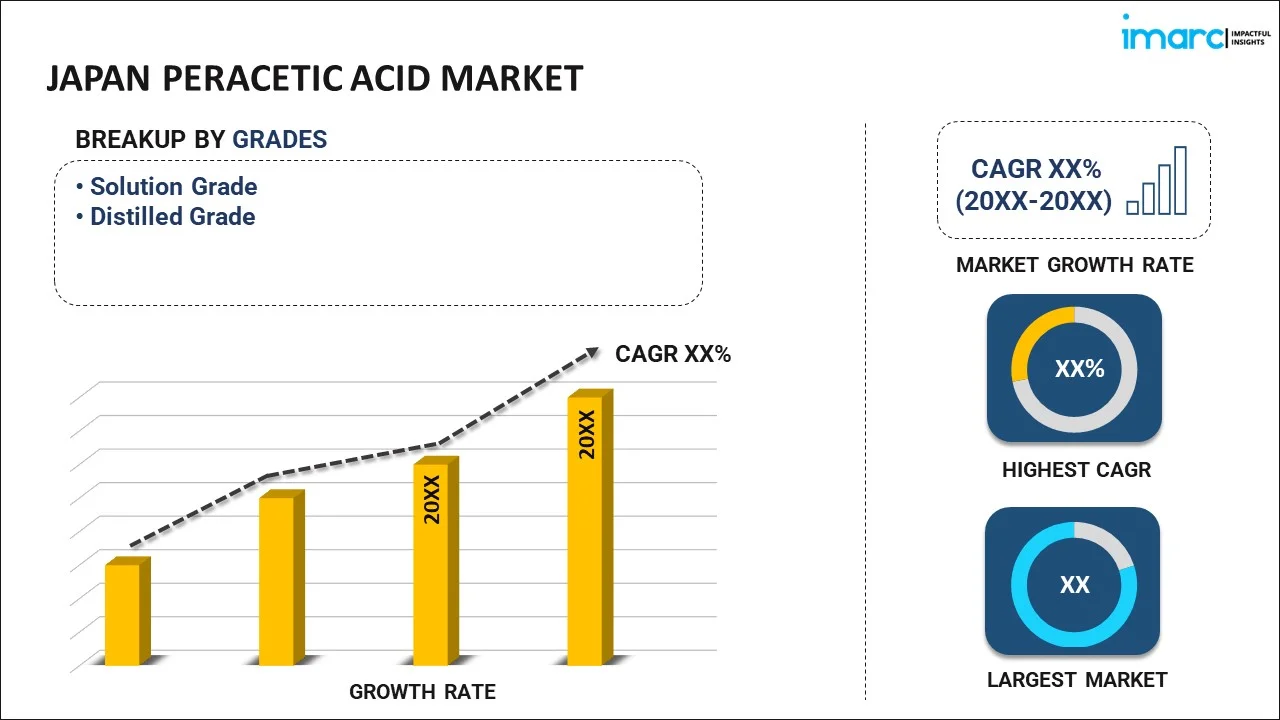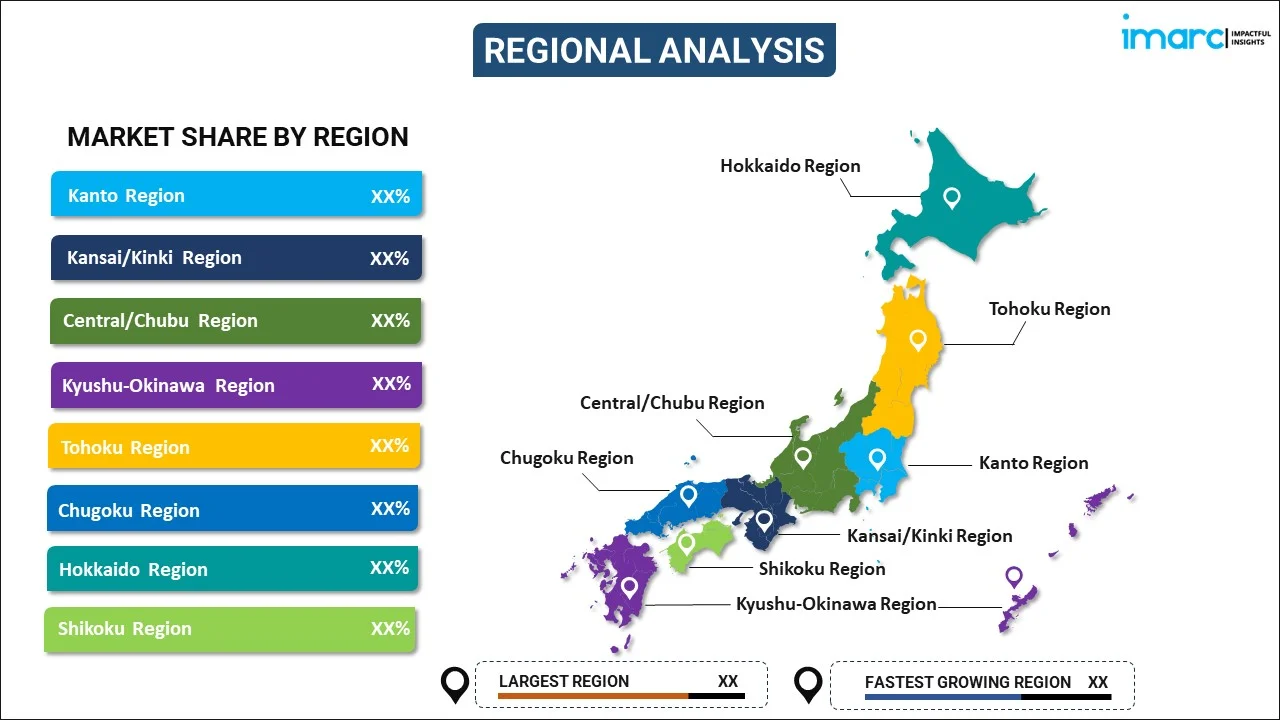
Japan Peracetic Acid Market Report by Grade (Solution Grade, Distilled Grade), Application (Disinfectant, Sterilant, Sanitizer, and Others), End Use Industry (Healthcare, Food and Beverage, Water Treatment, Pulp and Paper, and Others), and Region 2025-2033
Market Overview:
Japan peracetic acid market size reached USD 61.8 Million in 2024. Looking forward, IMARC Group expects the market to reach USD 96.6 Million by 2033, exhibiting a growth rate (CAGR) of 5.1% during 2025-2033. The escalating demand for processed and frozen food products is propelling the usage of peracetic acid to preserve the quality, freshness, and taste of meat products, which is primarily driving the market growth.
|
Report Attribute
|
Key Statistics
|
|---|---|
|
Base Year
|
2024
|
|
Forecast Years
|
2025-2033
|
|
Historical Years
|
2019-2024
|
| Market Size in 2024 | USD 61.8 Million |
| Market Forecast in 2033 | USD 96.6 Million |
| Market Growth Rate 2025-2033 | 5.1% |
Peracetic acid serves as a potent oxidizing agent extensively employed for its disinfection, sterilization, and sanitization attributes across diverse sectors, including food processing, healthcare, and water treatment. This chemical is characterized by its clear, colorless nature and remarkable reactivity, accompanied by a sharp odor reminiscent of acetic acid. Peracetic acid belongs to the peroxide family, characterized by the presence of an oxygen-oxygen single bond. Its synthesis involves the reaction between acetic acid and hydrogen peroxide, resulting in the in-situ production of peracetic acid. Notably, peracetic acid demonstrates exceptional efficacy against a wide spectrum of microorganisms, encompassing viruses, bacteria, fungi, and spores. Its antimicrobial action is broad, disrupting the cellular membranes of microorganisms, ultimately leading to their demise. Additionally, peracetic acid exhibits proficiency in eradicating biofilms, a common source of contamination in various industrial settings.
Japan Peracetic Acid Market Trends:
The burgeoning agricultural sector stands as a primary driver propelling the Japan peracetic acid market forward. This growth is substantiated by the widespread adoption of the agent in agriculture, where it effectively mitigates bacterial and fungal infestations in soil and crops. Furthermore, the market benefits from the increasing use of peracetic acid in water treatment applications to meet the escalating demand for safe and potable water supplies. Simultaneously, the healthcare domain contributes significantly to the demand for peracetic acid. Its use extends to surface disinfection, equipment sterilization, and high-level disinfection of medical instruments, all crucial aspects in the ongoing battle against hospital-acquired infections (HAIs). In addition, the pulp and paper industry utilizes peracetic acid to fulfill the mounting requirement for high-quality paper products while adhering to eco-friendly production practices. The eco-conscious consumer trend also fuels the adoption of peracetic acid in organic and natural products, ensuring the absence of harmful chemicals and toxins. The market's growth trajectory benefits further from innovations in reactor technology and optimized production processes, enhancing peracetic acid production capacity and fostering a positive market outlook. These factors will collectively fuel the market growth in the coming years.
Japan Peracetic Acid Market Segmentation:
IMARC Group provides an analysis of the key trends in each segment of the market, along with forecasts at the country level for 2025-2033. Our report has categorized the market based on grade, application, and end use industry.
Grade Insights:

- Solution Grade
- Distilled Grade
The report has provided a detailed breakup and analysis of the market based on the grade. This includes solution grade and distilled grade.
Application Insights:
- Disinfectant
- Sterilant
- Sanitizer
- Others
A detailed breakup and analysis of the market based on the application have also been provided in the report. This includes disinfectant, sterilant, sanitizer, and others.
End Use Industry Insights:
- Healthcare
- Food and Beverage
- Water Treatment
- Pulp and Paper
- Others
The report has provided a detailed breakup and analysis of the market based on the end use industry. This includes healthcare, food and beverage, water treatment, pulp and paper, and others.
Regional Insights:

- Kanto Region
- Kansai/Kinki Region
- Central/ Chubu Region
- Kyushu-Okinawa Region
- Tohoku Region
- Chugoku Region
- Hokkaido Region
- Shikoku Region
The report has also provided a comprehensive analysis of all the major regional markets, which include Kanto Region, Kansai/Kinki Region, Central/ Chubu Region, Kyushu-Okinawa Region, Tohoku Region, Chugoku Region, Hokkaido Region, and Shikoku Region.
Competitive Landscape:
The market research report has also provided a comprehensive analysis of the competitive landscape. Competitive analysis such as market structure, key player positioning, top winning strategies, competitive dashboard, and company evaluation quadrant has been covered in the report. Also, detailed profiles of all major companies have been provided. Some of the key players include:
- Merck KGaA
- Mitsubishi Gas Chemical Co.
- Ozu Corporation
- Solvay S.A.
(Please note that this is only a partial list of the key players, and the complete list is provided in the report.)
Japan Peracetic Acid Market Report Coverage:
| Report Features | Details |
|---|---|
| Base Year of the Analysis | 2024 |
| Historical Period | 2019-2024 |
| Forecast Period | 2025-2033 |
| Units | Million USD |
| Scope of the Report | Exploration of Historical and Forecast Trends, Industry Catalysts and Challenges, Segment-Wise Historical and Predictive Market Assessment:
|
| Grades Covered | Solution Grade, Distilled Grade |
| Applications Covered | Disinfectant, Sterilant, Sanitizer, Others |
| End Use Industries Covered | Healthcare, Food and Beverage, Water Treatment, Pulp and Paper, Others |
| Regions Covered | Kanto Region, Kansai/Kinki Region, Central/ Chubu Region, Kyushu-Okinawa Region, Tohoku Region, Chugoku Region, Hokkaido Region, Shikoku Region |
| Companies Covered | Merck KGaA, Mitsubishi Gas Chemical Co., Ozu Corporation, Solvay S.A., etc. |
| Customization Scope | 10% Free Customization |
| Post-Sale Analyst Support | 10-12 Weeks |
| Delivery Format | PDF and Excel through Email (We can also provide the editable version of the report in PPT/Word format on special request) |
Key Questions Answered in This Report:
- How has the Japan peracetic acid market performed so far and how will it perform in the coming years?
- What has been the impact of COVID-19 on the Japan peracetic acid market?
- What is the breakup of the Japan peracetic acid market on the basis of grade?
- What is the breakup of the Japan peracetic acid market on the basis of application?
- What is the breakup of the Japan peracetic acid market on the basis of end use industry?
- What are the various stages in the value chain of the Japan peracetic acid market?
- What are the key driving factors and challenges in the Japan peracetic acid?
- What is the structure of the Japan peracetic acid market and who are the key players?
- What is the degree of competition in the Japan peracetic acid market?
Key Benefits for Stakeholders:
- IMARC’s industry report offers a comprehensive quantitative analysis of various market segments, historical and current market trends, market forecasts, and dynamics of the Japan peracetic acid market from 2019-2033.
- The research report provides the latest information on the market drivers, challenges, and opportunities in the Japan peracetic acid market.
- Porter's five forces analysis assist stakeholders in assessing the impact of new entrants, competitive rivalry, supplier power, buyer power, and the threat of substitution. It helps stakeholders to analyze the level of competition within the Japan peracetic acid industry and its attractiveness.
- Competitive landscape allows stakeholders to understand their competitive environment and provides an insight into the current positions of key players in the market.
Need more help?
- Speak to our experienced analysts for insights on the current market scenarios.
- Include additional segments and countries to customize the report as per your requirement.
- Gain an unparalleled competitive advantage in your domain by understanding how to utilize the report and positively impacting your operations and revenue.
- For further assistance, please connect with our analysts.

 Inquire Before Buying
Inquire Before Buying
 Speak to an Analyst
Speak to an Analyst
 Request Brochure
Request Brochure
 Request Customization
Request Customization



.webp)




.webp)












